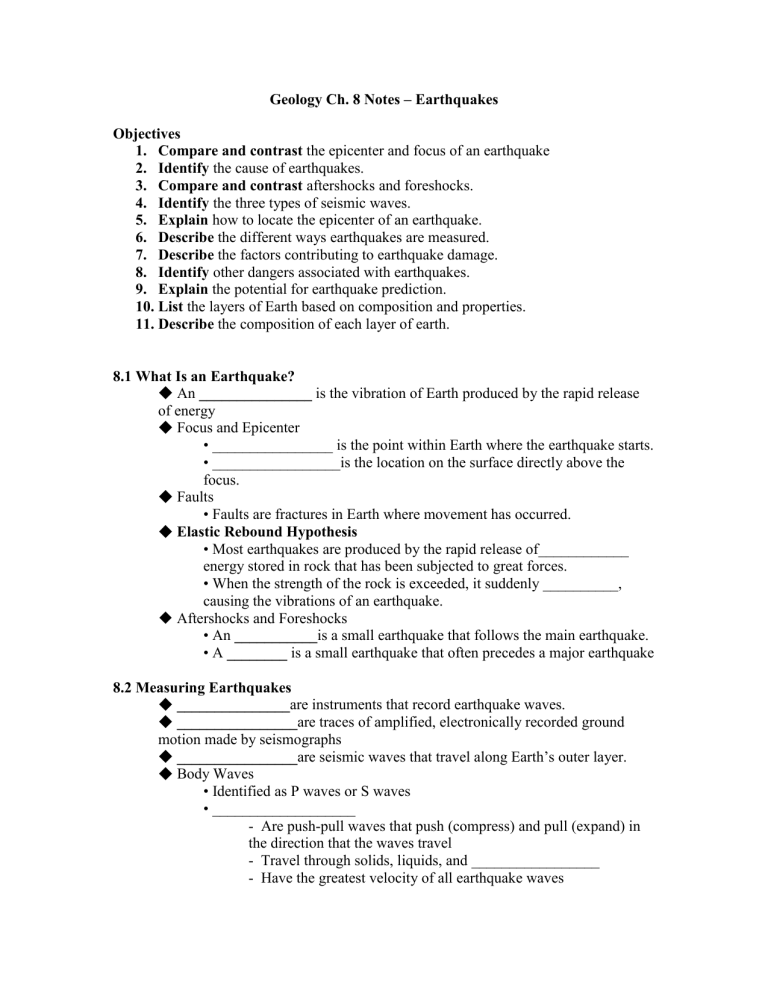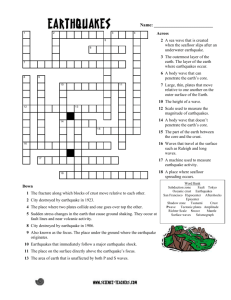click here to Ch. 8 Notes

Geology Ch. 8 Notes – Earthquakes
Objectives
1.
Compare and contrast the epicenter and focus of an earthquake
2.
Identify the cause of earthquakes.
3.
Compare and contrast aftershocks and foreshocks.
4.
Identify the three types of seismic waves.
5.
Explain how to locate the epicenter of an earthquake.
6.
Describe the different ways earthquakes are measured.
7.
Describe the factors contributing to earthquake damage.
8.
Identify other dangers associated with earthquakes.
9.
Explain the potential for earthquake prediction.
10.
List the layers of Earth based on composition and properties.
11.
Describe the composition of each layer of earth.
8.1 What Is an Earthquake?
An _______________ is the vibration of Earth produced by the rapid release of energy
Focus and Epicenter
• ________________ is the point within Earth where the earthquake starts.
• _________________is the location on the surface directly above the focus.
Faults
• Faults are fractures in Earth where movement has occurred.
Elastic Rebound Hypothesis
• Most earthquakes are produced by the rapid release of____________ causing the vibrations of an earthquake.
Aftershocks and Foreshocks
• An
___________ is a small earthquake that follows the main earthquake.
• A ________ is a small earthquake that often precedes a major earthquake energy stored in rock that has been subjected to great forces.
• When the strength of the rock is exceeded, it suddenly __________,
8.2 Measuring Earthquakes
_______________ are instruments that record earthquake waves.
________________ are traces of amplified, electronically recorded ground motion made by seismographs
________________ are seismic waves that travel along Earth’s outer layer.
Body Waves
• Identified as P waves or S waves
• ___________________
- Are push-pull waves that push (compress) and pull (expand) in the direction that the waves travel
- Travel through solids, liquids, and _________________
- Have the greatest velocity of all earthquake waves
8.2 Measuring Earthquakes
Body Waves
• __________________________
- Seismic waves that travel along Earth’s outer layer
- Shake particles at right angles to the direction that they travel
- Travel only through solids
- __________________velocity than P waves
A __________________shows all three types of seismic waves—surface waves, P waves, and S waves
Earthquake Distance
• The epicenter is located using the difference
in the ____________________between P and S wave
Recordings, which are related to distance.
Earthquake Direction
• Travel-time graphs from three or more
seismographs can be used to find the exact
location of an earthquake_____________________.
Earthquake Zones
• About___percent of the major earthquakes occur in a few narrow zones.
Historically, scientists have used two different types of measurements to describe the size of an earthquake
—intensity and _____________________
Richter scale
• Based on the _______________of the largest seismic
wave
• Each unit of Richter magnitude equates to roughly a _______________energy increase
• Does not estimate adequately the size of very large earthquakes
Momentum Magnitude
• Derived from the amount of displacement that occurs along the_______ zone
• Moment magnitude is the most widely used measurement for earthquakes because it is the only magnitude scale that estimates the
_______________released by earthquakes.
• Measures very _______________earthquakes
The damage to buildings and other structures from earthquake waves depends on several factors. These factors include the intensity and duration of the vibrations, the nature of the material on which the structure is built, and the
___________of the structure.
Building Design
• Factors that determine structural damage
- _______________of the earthquake
- _________________stone or brick buildings are the most serious safety threats
- Nature of the material upon which the structure rests
- The design of the structure
_________________________
• Saturated material turns fluid
• Underground objects may float to surface
8.3 Destruction from Earthquakes
Cause of Tsunamis
• A
___________________ triggered by an earthquake occurs where a slab of the ocean floor is displaced vertically along a fault.
• A tsunami also can occur when the vibration of a quake sets an underwater landslide into motion.
Cause of Tsunamis
• A
________________ triggered by an earthquake occurs where a slab of the ocean floor is displaced vertically along a fault.
• A tsunami also can occur when the vibration of a quake sets an underwater landslide into motion.
• Tsunami is the ________________word for “seismic sea wave.”
Tsunami Warning System
• Large earthquakes are reported to Hawaii from Pacific seismic stations.
• Although tsunamis travel quickly, there is sufficient time to evacuate all but the area closest to the_____________________.
Landslides
• With many earthquakes, the greatest damage to structures is from landslides and___________________, or the sinking
Fire of the ground triggered by vibrations.
• In the San Francisco earthquake of 1906, most of the destruction was caused by fires that started when
______________lines were cut.
Short-Range Predictions
• So far, methods for short-range predictions of earthquakes have not been
____________________________________
Long-Range Forecasts
• Scientists don’t yet understand enough about how and where earthquakes will occur to make accurate long-term predictions.
• A
________________________ is an area along a fault where there has not been any earthquake activity for a long period of time.
8.4 Earth’s Layered Structure
Earth’s interior consists of three major zones defined by their chemical composition—the crust, mantle, and core.
______________________
• Thin, rocky outer layer
• Varies in thickness
- Roughly 7 km in oceanic regions
- Continental crust averages 8–40 km
- Exceeds 70 km in mountainous regions
Crust
• _____________________
- Upper crust composed of granitic rocks
- Lower crust is more akin to basalt
- Average density is about 2.7 g/cm3
- Up to 4 billion years old
• _____________________
- Basaltic composition
- Density about 3.0 g/cm3
- Younger (180 million years or less) than the continental crust
____________________________
• Below crust to a depth of 2900 kilometers
• Composition of the uppermost mantle is the igneous rock peridotite
(changes at greater depths).
___________________________
• Below mantle
• Sphere with a radius of 3486 kilometers
• Composed of an iron-nickel alloy
• Average density of nearly 11 g/cm3
________________________
• Crust and uppermost mantle (about 100 km thick)
• Cool, rigid, solid
________________________
• Beneath the lithosphere
• Upper mantle
• To a depth of about 660 kilometers
• Soft, weak layer that is easily deformed
____________________________
• 660–2900 km
• More rigid layer
• Rocks are very hot and capable of gradual flow.
____________________________
• Sphere with a radius of 1216 km
• Behaves like a solid
Outer Core
• Liquid layer
• 2270 km thick
• Convective flow of metallic iron within generates Earth’s
_____________
___________________
• Velocity of seismic waves increases abruptly below 50 km of depth
• Separates crust from underlying mantle
Shadow Zone
• Absence of P waves from about 105 degrees to 140 degrees around the globe from an earthquake
• Can be explained if Earth contains a core composed of materials unlike the overlying ________________________
Crust
• Early seismic data and drilling technology indicate that the continental crust is mostly made of lighter, granitic rocks.
Mantle
• Composition is more speculative
• Some of the lava that reaches Earth’s surface comes from asthenosphere within.
Core
• Earth’s core is thought to be mainly dense iron and nickel, similar to metallic meteorites. The surrounding mantle is believed to be composed of rocks similar to stony meteorites.
Definitions:
1.
earthquake: the vibration of earth produced by the rapid release of energy
2.
focus: the point within Earth where an earthquake originates
3.
epicenter: the location on Earth’s surface directly above the focus, or origin, of an earthquake
4.
fault: a fracture in Earth along which movement has occurred
5.
elastic rebound hypothesis: the explanation stating that when are rocks are deformed , they break, releasing the stored energy that results in the vibrations of an earthquake
6.
aftershock: a small earthquake that follows the main earthquake
7.
foreshock: a small earthquake that often precedes a major earthquake
8.
seismograph: an instrument that records earthquake waves
9.
seismogram: the record made by a seismograph
10.
surface wave: a seismic wave that travels along the surface of Earth
11.
P wave: earthquake wave that pushes and pulls rocks in the direction of the wave, also known as a compression wave
12.
S wave: a seismic wave that shakes particles perpendicular tot eh direction the wave is traveling, also called a transverse wave
13.
Richter scale:
14.
Modified Mercalli scale: a measure of how strong an earthquake felt and how much damage it did at a particular location
15.
Moment magnitude: a more precise measure of earthquake magnitude than the
Richter scale, which is derived from the amount of displacement that occurs along a fault zone and estimates the energy released by an earthquake.
16.
Liquefaction: a phenomenon sometimes associated with earthquakes, in which soils and other unconsolidated materials saturated with water are turned into a liquid that is not able to support buildings.
17.
tsunami: the Japanese word for a seismic sea wave
18.
Seismic gap: an area along a fault where there has not been any earthquake activity for a long time.
19.
crust: the rocky outer layer of Earth
20.
mantle: the 2890 km.-thick layer of Earth located below the crust
21.
lithosphere: the rigid outer layer of Earth, including the crust and upper mantle
22.
Asthenosphere: a weak plastic layer of the mantle situated below the lithosphere.
The rock within this layer is easily deformed
23.
outer core: a layer below the mantle about 2260 km thick: the outer core contains liquid iron and generates Earth’s magnetic field
24.
inner core: a solid innermost layer of Earth, about 1220 km radius
25.
Moho: The Mohorovicic discontinuity, which is shortened to Moho; It is the boundary separating the crust from the mantle, discernable by an increase in the velocity of seismic waves.








